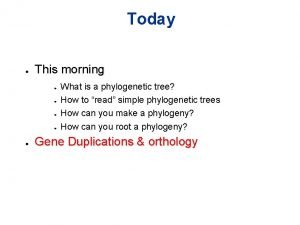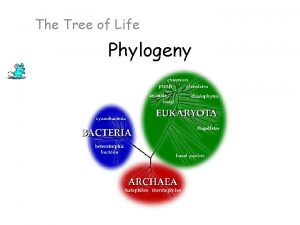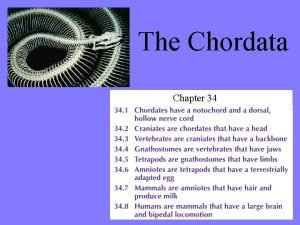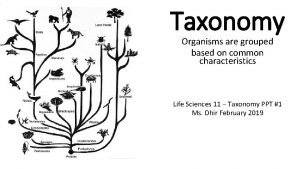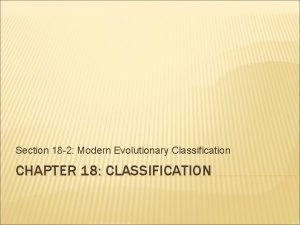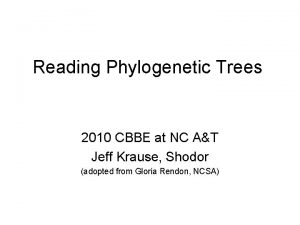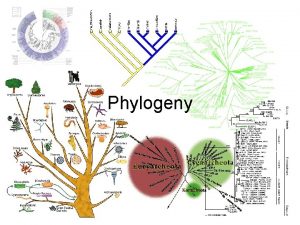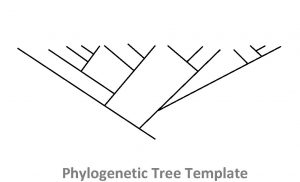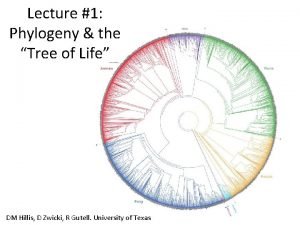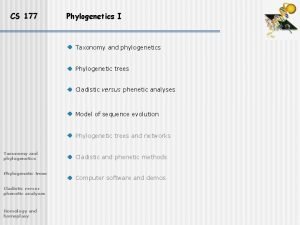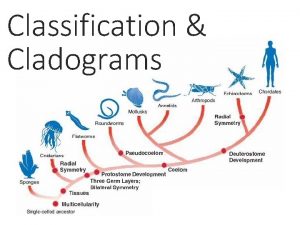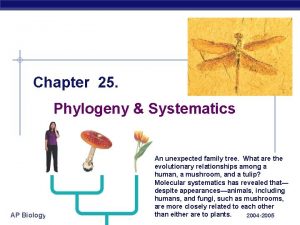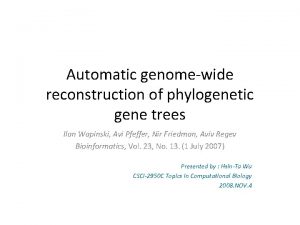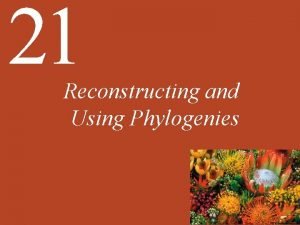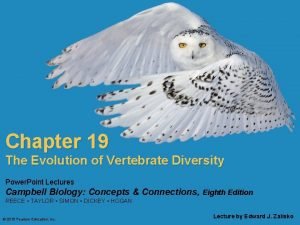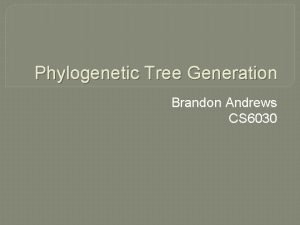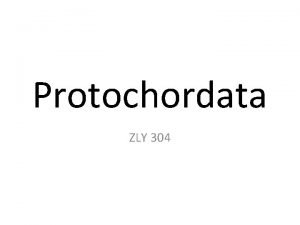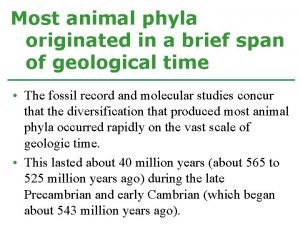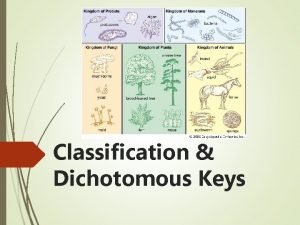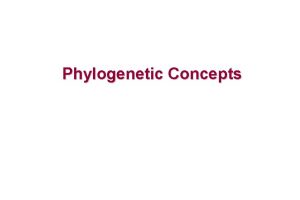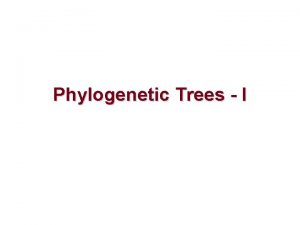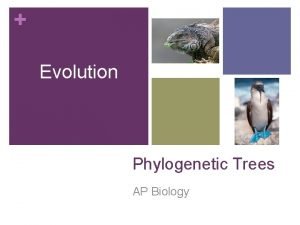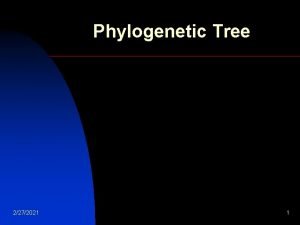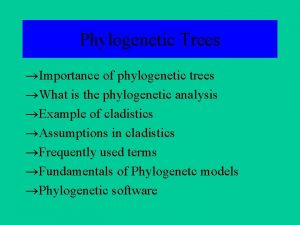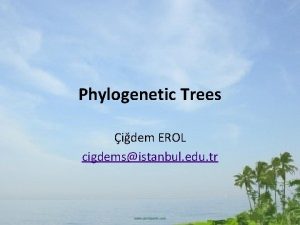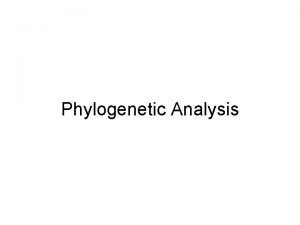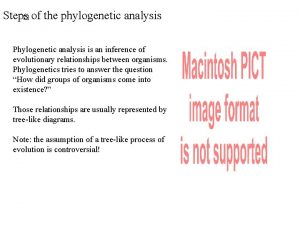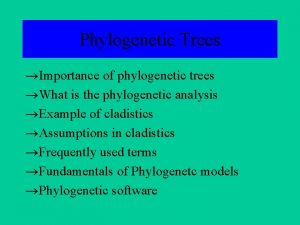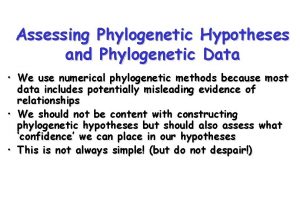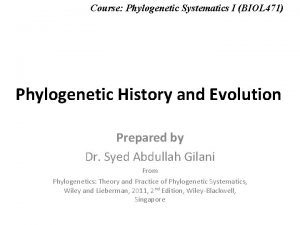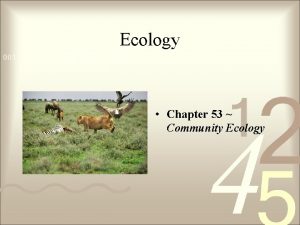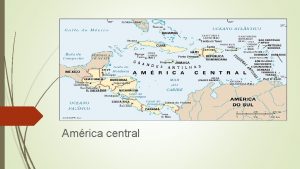Community Phylogenetic structure with R Central question in

























- Slides: 25

Community Phylogenetic structure with R

• Central question in community ecology • What processes are responsible for the identity and relative abundances of co-occurring species in local assemblages? • What is the relative importance of different ecological processes in structuring communities • Search for patterns in community structure that may reflect underlying processes

Community assembly processes Niche and trait evolution Patterns of phylogenetic community structure Phylogenetic data

Patterns of phylogenetic community structure • Phylogenetic clustering – Co-occurring species are more closely related than expected by chance • Phylogenetic overdispersion/evenness – Co-occurring species are more distantly related than expected by chance • Random patterns

Community assembly processes • Many processes could influence phylogenetic community structure – Facilitation – Negative density dependent processes (e. g. herbivory, predation) – Indirect interactions mediated by herbivores, parasites, pathogens – Disturbance e. g. fire – Speciation • Two main processes are usually considered

Habitat filtering • Adaptation of species to abiotic conditions – Communities composed of ecologically similar species – Environment imposes a filter via abiotic conditions favoring species with similar adaptations Emerson & Gillepsie, 2008

Competitive exclusion – The principle of competitive exclusion: similar species cannot coexist indefinitely. – Related species are ecologically similar • Prediction: closely related species should co-occur less than would be expected • Early efforts tested this hypothesis using – species : genus ratios – Taxonomic community structure Emerson & Gillepsie, 2008

Phylogenetic signal Kembel, 2009

Community phylogenetic structure (Competitive exclusion) Kembel, 2009 (or clustering)

Clustering: Co-occurring species are more closely related than expected by chance Over-dispersion: Co-occurring species are more distantly related than expected Clustering due to environmental filtering Over-dispersion due to competitive exclusion Clustering due to competitive exclusion Over-dispersion due to environmental filtering Trait conservatism Trait convergence h

Emerging patterns • Communities structured by several processes acting in concert – Mediated by different sets of traits • Scale is important – Taxonomic scale (Cavender-Barres et al. , 2004; 2006) • Oaks: phylogenetic over dispersion • Angiosperms: phylogenetic clustering – Spatial scales • Similar shift from smaller (overdispersion) to larger spatial scales (clustering)

Steps • Quantify the degree of relatedness among cooccurring species using a phylogeny • Define a broader pool of species from which communities have been assembled • Construct a null model which generates random communities from the broader species pool • Determine phylogenetic signal for functional traits that influence community assembly

Data • Phylogenetic tree for regional/broader species pool – Entire species in all the communities • Species list and presence/absence or abundance data for the different communities, plots or specific habitats within a community.

Getting a phylogenetic tree • Can use either sequence data or species list • Different formats: Newick, Nexus • Online tools available e. g. – Genbank (http: //www. ncbi. nlm. nih. gov/): can obtain raw sequence data – ARB/Silva (http: //www. arb-silva. de/): provides aligned sequence data free for academic use – RDP (http: //rdp. cme. msu. edu/ ): provides sequence data and builds phylogenetic tree – Beast (http: //beast. bio. ed. ac. uk/Main_Page): contains programs to create phylogenies with sequence data – Phylomatic (http: //www. phylodiversity. net/phylomatic/): assembles phylogenies using species lists.

Quantifying degree of relatedness Vamosi et al. , 2009

Within community measures • Faith’s phylogenetic diversity (PD) – Total branch length spanned by the tree including all species in a local community. • A lower value indicates that – Taxa are clumped on the phylogeny – Capture only a small part of the total phylogenetic diversity present in the entire phylogeny – Co-ocurring species are more closely related

• MPD: Mean pair-wise distance between all species in a community – Measures whether species in a community are more closely related than expected by chance (using a null model and the regional species pool) – MPD is more sensitive to tree-wide phylogenetic patterns • MNTD: Mean distance to nearest taxon for each species in the community – Measures whether closely related species tend to co-occur or not (using a null model and the regional species pool). – MNTD is more sensitive to patterns of evenness and clustering closer to the tips of the phylogeny

Distance matrix Kembel, 2009

Null models • Randomize the phylogeny – Phylogeny shuffle: randomizes phylogenetic relationships among species by shuffling the taxa on the tips. – Randomize tree structure • Randomize community structure – Randomize draws from species pool • Species in each sample are random draws from the – Sample pool: maintains species richness of each sample but species are drawn without replacement from the list of all species actually occurring in the sample. – Regional species pool: maintains species richness, but species are drawn without replacement from a broader phylogeny pool. – Randomize community matrix • Independent swap: creates swapped versions of the sample/species matrix; only applicable with presence/absence data.

Randomization • Using null model – Generate a random community – Recalculate metrics i. e. MPD/MNTD – Repeat many times • Result: distribution of metric values for random communities

Standardized effect sizes (SES) • SES=(Observed value – Mean (random values))/SD(random values) • Net relatedness index (NRI): standardized metric obtained by comparing MPDobs and MPDexp – + NRI = phylogenetic clustering – - NRI = phylogenetic evenness – Calculated as standardized effect size (SES) in picante • SES = -1 x NRI

SES continued • Nearest taxon index (NTI): obtained by comparing MNTDobs and MNTDexp – + NTI = phylogenetic clustering – - NTI = phylogenetic evenness – Computed as standardized effect size (SES) in picante • SES = -1 x NTI

Phylogenetic Beta Diversity • Measures patterns of phylogenetic relatedness among communities – Among communities equivalent of MPD and MNTD using pairs of species drawn from different communities – can be used with any method based on among-community distances • e. g. cluster analysis, phyloordination, Mantel tests with spatial/environmental distances separating communities.

Today’s Data • Bird communities along 3 highways: 64, 44, and 55 – Gradient from urban (1) to rural (5) along those highways, with each community separated by 16 km – Ex. Communities: RD 441, RD 442, RD 443, RD 641, RD 642, etc… RD 64 1 2 3 ? ? ? 4 5

• Genetic data from Genbank using 2 mitochondrial genes – Cytochrome b (Cytb) and Cytochrome c oxidase subunit I (COI) – Made a phylogeny using Beast and Beauti (free online, easy to use, and comes with a short tutorial and good manual) • Question: What is the phylogenetic structure of communities as you go from rural to urban environments? RD 64 1 2 3 ? ? ? 4 5
 Levels of questioning examples
Levels of questioning examples Polytomy definition
Polytomy definition Species tree
Species tree Ingroup phylogenetic tree
Ingroup phylogenetic tree Chordate phylogeny
Chordate phylogeny Difference between cladogram and phylogenetic tree
Difference between cladogram and phylogenetic tree Section 18-2 modern evolutionary
Section 18-2 modern evolutionary Reading phylogenetic trees
Reading phylogenetic trees Building vocabulary: phylogenies
Building vocabulary: phylogenies Phylogenetic tree outline
Phylogenetic tree outline 8 levels of classification
8 levels of classification Phylogenetic tree example
Phylogenetic tree example Basal group phylogeny
Basal group phylogeny Site:slidetodoc.com
Site:slidetodoc.com Rooted unscaled tree
Rooted unscaled tree Biological classification pogil
Biological classification pogil Phylogenetic tree kingdoms
Phylogenetic tree kingdoms Ap biology phylogenetic tree
Ap biology phylogenetic tree Extant species phylogenetic tree
Extant species phylogenetic tree Monophyletic vs paraphyletic vs polyphyletic
Monophyletic vs paraphyletic vs polyphyletic Monocot leaf
Monocot leaf Chegg
Chegg Distabc
Distabc Larvacea
Larvacea Acoleomate
Acoleomate Branching key example
Branching key example


